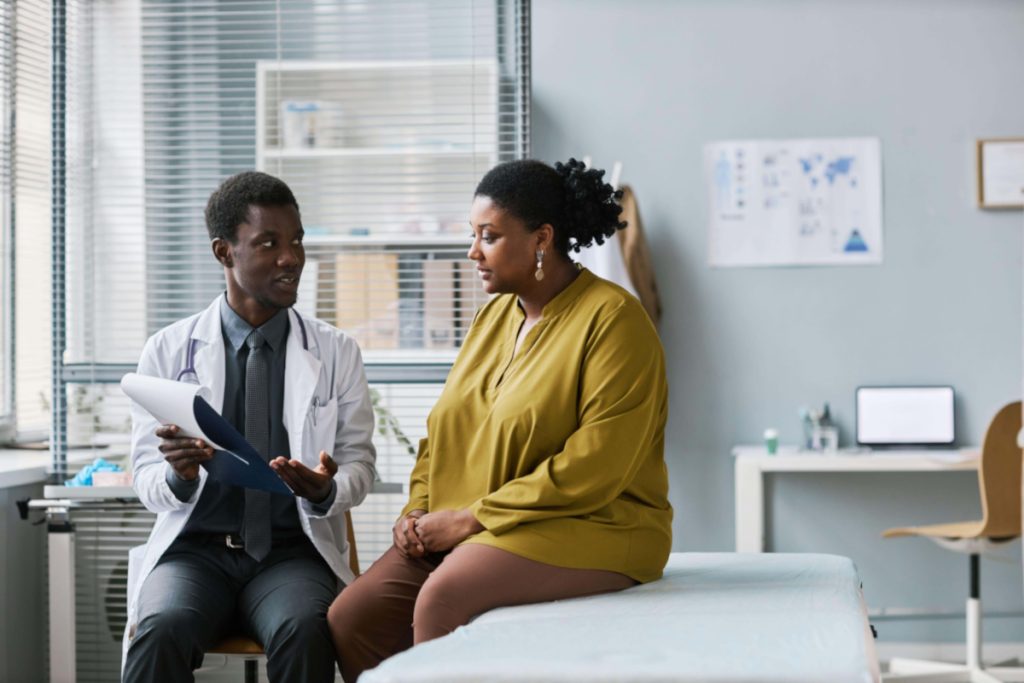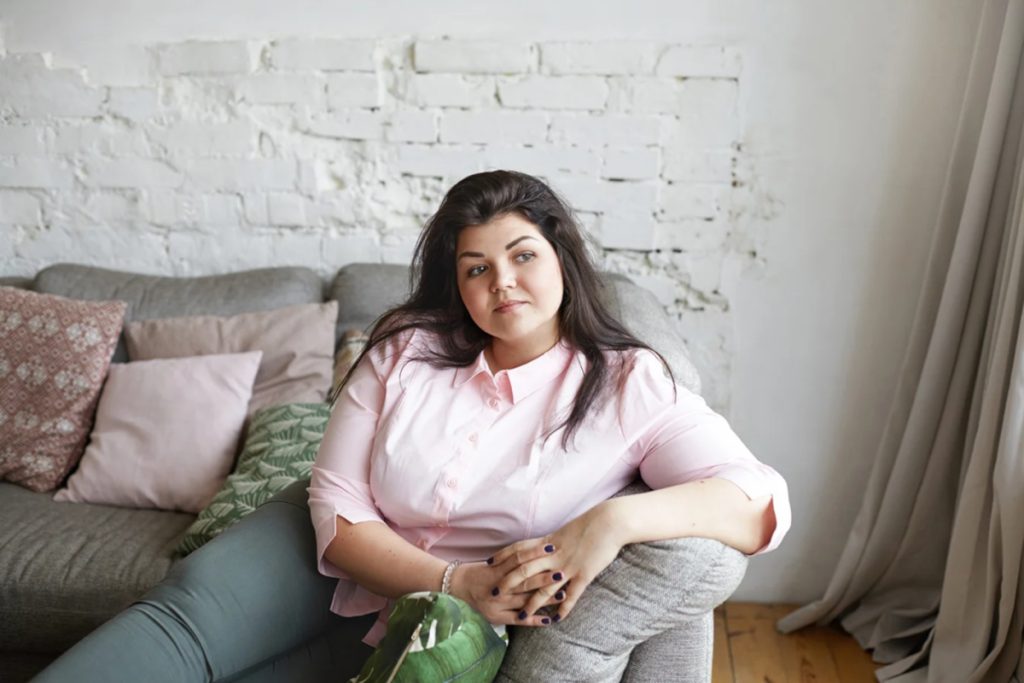Over the past few years, plenty of work has been done to shine an important light on the conversation about uterine fibroids. Whether it’s new legislation to bring Fibroid Awareness Month to more states, an increase in educational material and access to care, or innovative technology to give women more treatment options, it’s safe to say more women than ever before are being supported and cared for while at the same time understanding their condition and gaining confidence from the very start. And yet, there is still much work left to be done. The physical pain and life interrupting issues fibroids can cause has been well documented for the estimated 171 million women worldwide who have them. But there is still a recognizable stigma surrounding this conversation.
This is why we chose Stress Awareness Month to bring the emotional impact of fibroids out into the open and destigmatize the conversation once and for all. Women need to feel comfortable talking about their symptoms and sharing their journey. Period problems caused by fibroids is not a normal part of being a woman, and we should not be suffering physically, mentally, and emotionally in silence. Furthermore, there is a need for doctors to inform patients that there are less invasive options to free them from the shackles of their fibroid issues.
Understanding the Emotional Impact Fibroids Cause
Fibroids are benign tumors that develop from the muscle tissue of the uterus. Researchers estimate that 70-80 percent of all women develop fibroids between 35 and 54, and they can develop in different locations, differ in size, and either stay that way or grow at different rates. Many women are unaware they have fibroids and will accidentally discover them during a routine exam with their doctor.
In other situations, patients may experience fibroid pain and other life-altering symptoms ranging from heavy menstrual bleeding and weight gain to pain during sex, back or leg pain, debilitating cramps, bowel or bladder dysfunction, and excessive fatigue. As these symptoms worsen over time, the cost to her quality of life goes well beyond physical suffering. In many women, there is a heavy emotional toll on well-being, self-esteem, and overall body positivity.
- Sexuality concerns — Pain during sex, bloating, and more can interfere with a woman’s sex life. Beyond the sexual act, she can develop feelings of inadequacy and undesirability in the eyes of her partner. According to Care About Fibroids, a 2013 national survey said 52% of women with fibroids worry about their sexual function.
- Fear of future health complications — In the same study above, 79% of women who participated in the survey worried that their fibroids would grow, and 55% feared needing a hysterectomy or that they would develop cancer, despite that fact that fibroid tumors are benign.
- Lingering questions and fear about uterine fibroid surgery — The thought of going through a surgical procedure creates stress and plenty of fear of the unknown. How long will the recovery be? How will my body react? Is it safe? Will I be able to have children again? Will my life be forever changed because of this condition?
- Feelings of helplessness — The emotional response to painful uterine fibroids can include everything from fear and anxiety to stress, anger, sadness, feelings of hopelessness and helplessness, and even depression. Stress, in particular, can cause fibroids that were once asymptomatic to grow at an alarming rate because, to handle stress, the brain tells our body to produce extra hormones. Fibroid growth is stimulated as hormone levels rise.
- Inability to be active — The emotional toll of not being as active as you once were can be a tough pill to swallow. As a result, many women experience uncontrolled weight gain as they cut back on physical, daily, and social activities with friends and family. In addition, fibroids themselves can cause enlarged uterus, displaying a pregnancy-looking body.
- Feelings of being alone on their journey — Many women genuinely feel there is an overall lack of support and an overall lack of understanding of what they are experiencing. This can come from their families, spouses, and primary healthcare providers.

Women Are Hesitant To Report Their Symptoms
The lack of dialogue and misinformation that still exists about uterine fibroids—even with continued awareness, education, and outreach—has contributed to women feeling woefully unprepared for the journey and uneducated about their options. Many women aren’t aware they have fibroids, don’t have access to adequate information or treatment, normalize their symptoms as part of being a woman, and are hesitant to report them. According to a study published by the National Institutes of Health, women wait an average of 3.6 years before seeking treatment.
This is especially true for Black women, who are three times more likely to develop fibroids than any other ethnic group. In fact, 80% of Black women will develop fibroids by the time they are 50, compared to 70% of white women. And many of these women appear to prefer to suffer in silence. A study published in the Journal of Women’s Health states that Black women take an average of almost four years to seek treatment. By this point, their symptoms are likely worse, and the number of uterine fibroids they now have doubled in size and quantity—making treatment that much more difficult. The study went on to say that Black women were also more likely than white women to view the fibroid information they did receive as inadequate, requesting more information such as:
- More about uterine fibroids in general
- Standard treatment options
- Alternative treatment options
- Consequences of treatment
Another factor is that many women believe they have inadequate health insurance and won’t be able to cover the out-of-pocket expenses that come with any form of medical intervention. The time of year could also play a factor, as most patients wait until the end of the year when they have satisfied their deductible or until the beginning of the year when they know they can reach their deductible with one procedure.

6 Ways to Destigmatize the Conversation About Uterine Fibroids
1. Speak up about your uterine fibroid journey
2. Understand your condition (no, it’s not a normal part of being a woman)
3. Get involved with awareness efforts in your community
4. Build a support system
5. Join uterine fibroid online communities
6. Educate yourself on surgical and alternative treatment options
Surgical and Alternative Fibroid Treatment Options
It’s important to know that 1) You have options, and 2) There is a difference between fibroid removal and fibroid treatment. Fibroid removal typically involves a bloody surgical procedure and a lengthy recovery process where a doctor makes an incision or several incisions and safely removes your fibroids. Conversely, fibroid treatment doesn’t necessarily mean “removing” a fibroid as much as it does finding alternative methods to provide relief.
Once you have a diagnosis, your doctor may recommend the following fibroid removal and fibroid treatment options:
- Uterine Fibroid Embolization (UFE) — UFE is a minimally-invasive procedure that, rather than removing fibroids with numerous incisions, cuts off blood flow to all fibroids—causing them to shrink and die. UFE is low risk, has no incision, is faster than other options, and is an alternative to surgery.
- Acessa — A small probe is placed into a fibroid and heated. By heating the fibroid, it is ultimately destroyed. Acessa works even if you have several uterine fibroids. But there are limitations. For example, if you have multiple large fibroids (melon or grapefruit size) or fibroids that are hard to get to, Acessa is not a good choice. It is also not covered by some insurance companies.
- Endometrial Ablation — Removes the uterine lining by placing a thin instrument into the uterus through the cervix and using heat, laser, electricity, microwaves, or freezing. The downside to endometrial ablation is that it is not safe to get pregnant after you’ve had it. In addition, it is most effective with only small fibroids and will not treat fibroids outside the interior uterine lining.
- Sonata System — This incision-less fibroid treatment works well when the patient has one or several fibroids. Using an intrauterine ultrasound device, radiofrequency energy is delivered to the fibroid to shrink the fibroid. As the fibroid shrinks, the patient can see a reduction in painful symptoms. Studies show fibroids larger than 5.0 cm may require the application of multiple ablations.
- Myomectomy — Myomectomy preserves the uterus while removing the fibroids. As a result, it is the surgical procedure of choice for women who want to get pregnant. However, it eliminates the ability to have a vaginal birth in the future and does require a longer recovery time as consistent with surgeries. The size and location of the fibroids determine how this surgery is performed.
- Hysterectomy — This popular form of fibroid removal is still widely used today. It is also effective, though many women hope to avoid it due to its invasive nature. A hysterectomy removes all or part of a woman’s uterus. In some cases, her fallopian tubes and ovaries are removed, too. It’s important to note that it takes longer to heal from a hysterectomy, and your body will never be the same again.

Don’t Suffer With Uterine Fibroids. Our Fibroid Experts Want To Help
Now more than ever, it is important to continue to destigmatize the conversation about uterine fibroids. Yes, we have made tremendous strides in recent years to shine an important light on this condition. There have been so many incredible wins along the way, too. But there are still far too many women who think what they are experiencing is normal, either because they are fearful of what comes next or they don’t know they have options.
At Fibroid Institute, we are dedicated to educating and empowering women on fibroid treatment options. With multiple locations, our Houston and Dallas fibroid centers help thousands of women avoid fibroid surgery and find relief from their fibroid symptoms. Our fibroid doctors are board-certified interventional radiologists and experts passionate about helping women become #FibroidFree. Dr. Suzanne Slonim and Dr. John Fischer are highly experienced UFE specialists and 100% focused on fibroid issues.
Request a free 10-15 minute phone screening to determine if you are eligible. After the screening, if you qualify for UFE, you can schedule your onsite or telehealth consultation. Most major medical insurance providers cover the cost of UFE. Get started now with Fibroid Institute Dallas at 214-838-6440 or with Fibroid Institute Houston at 713-903-3733 or complete the form below.
This information is not a substitute for professional medical advice. Prior to starting any new treatment or if you have questions regarding a medical condition, always seek the advice of your doctor or other qualified health provider.
Fibroid Institute Texas serves the Dallas and Houston areas including Addison, Carrollton, Plano, Frisco, Craig Ranch, McKinney, Allen, Fort Worth, Grand Prairie, HEB, Arlington, Hutchins, Irving, Duncanville, DeSoto, Cedar Hill, Lancaster, Cockrell Hill, Highland Park, University Park, Park Cities, Garland, Mesquite, Richardson, Dallas, Sherman, Houston, Sugar Land, Katy, Webster, Clear Lake, The Woodlands, Universal City, Spring, Kingwood, Stafford, Conroe, Texas City, Cypress, League City, Bellaire, and more.
*Patient stories are true. Names and/or photos may be changed to protect patient confidentiality.

